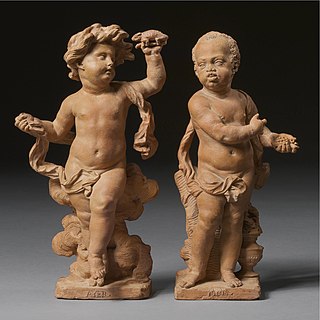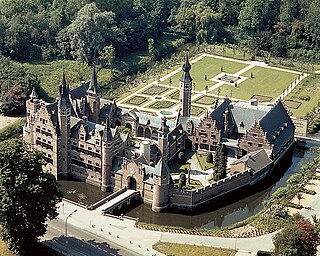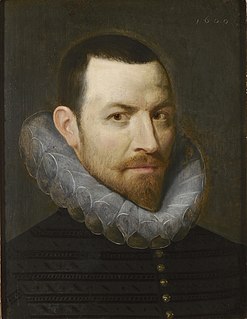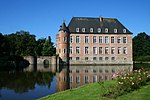
Bouchout Castle is a castle in the Flemish town of Meise, Belgium. In the 12th century, this territory of the young Duchy of Brabant was strategically positioned between the County of Flanders and the Berthout family, lords of Grimbergen. Most likely, the first fortification was built by Wouter van Craaynem at the end of the Grimbergen Wars (1150–1170). Bouchout Castle is situated at an altitude of 32 meters.

The Stadhuis of Antwerp, Belgium, stands on the western side of Antwerp's Grote Markt. Erected between 1561 and 1565 after designs made by Cornelis Floris de Vriendt and several other architects and artists, this Renaissance building incorporates both Flemish and Italian influences. The Stadhuis is listed as one of the Belfries of Belgium and France, a UNESCO World Heritage Site.

The Castle de Renesse is a castle located in the village of Oostmalle (Malle), in the Campine region of the province of Antwerp. It is currently owned by the municipality of Malle.

Museum Geelvinck Hinlopen Huis was situated from its opening 1991 till the end of 2015 in a canal-side mansion, the Geelvinck Hinlopen Huis in Amsterdam, the Netherlands. This patrician mansion, close to the Rembrandtplein, was built for Albert Geelvinck (1647-1693) and Sara Hinlopen (1660-1749), then in an attractive and new laid-out section of the city towards the Amstel. In the year 1687 the couple moved into this double wide house, with storage rooms in the cellar, under the attic and in the warehouse on Keizersgracht 633, now the entrance.

Maerten de Vos, Maerten de Vos the Elder or Marten de Vos was a Flemish painter. He is known mainly for his history and allegorical paintings and portraits. He was, together with the brothers Ambrosius Francken I and Frans Francken I, one of the leading history painters in the Spanish Netherlands after Frans Floris career slumped in the second half of the sixteenth century as a result of the Iconoclastic fury of the Beeldenstorm.

Tobias Verhaecht (1561–1631) was a Flemish painter primarily of landscapes. His style was indebted to the mannerist world landscape developed by artists like Joachim Patinir and Pieter Bruegel the Elder. He was the first teacher of Pieter Paul Rubens.

Moyland Castle is a moated castle in Bedburg-Hau in the district of Kleve, one of the most important neo-Gothic buildings in North Rhine-Westphalia. Its name derives from the Dutch word Mooiland which means "beautiful country". The name was probably coined by Dutch workers, whom the then-leaseholder Jacob van den Eger of the Lower Rhine brought to the property in 1307 to drain the surrounding wetlands.

Antwerp is a city in Belgium and the capital of Antwerp Province in the Flemish Region. With a population of 520,504, it is the most populous city proper in Belgium, and with a metropolitan population of around 1,200,000 people, it is the second-largest metropolitan region after Brussels.

Jan Claudius de Cock was a Flemish painter, sculptor, print artist and writer. De Cock produced both religious and secular sculpture on a small as well as monumental scale. De Cock completed many commissions in the Dutch Republic. He worked on decorations for the courtyard of the Breda Palace for William III, King of England, Ireland, and Scotland and stadtholder. He is credited with introducing neoclassicism in Flemish sculpture. He was a prolific draughtsman and designed prints for the Antwerp publishers. As a writer, he wrote a poem about the 1718 fire in the Jesuit Church in Antwerp and a book of instructions on the art of sculpture.

Ter Worm or Terworm Castle is a castle located in the municipality of Heerlen, Limburg Province, Netherlands. The castle is part of the Terworm estate.

The Sterckshof castle is in Deurne, Antwerp, Belgium. From 1994 to 2014 it housed the Sterckshof silver museum of the Province of Antwerp. Built on the site of a much older castle, or great house, the present building is a reconstruction erected in the 1920s.

St. Andrew’s Church is a Catholic church in Antwerp built in the 16th century. Its exterior is mainly characterised by a late-Gothic style while its interior is predominantly executed in Baroque style. It is the parish church of the Parish of St. Andrew’s. During the nineteenth century the St. Andrew's Parish was known as the parish of misery as it was by then mainly populated by poor people.

Eijsden Castle is a moated manor house with several farm buildings, a gatehouse and castle park, in Eijsden-Margraten, Limburg, Netherlands. The current castle was built in 1637 and is located next to the river Maas.

The St. Paul's Church or Sint-Pauluskerk is a Roman Catholic church located at the Veemarkt in Antwerp. Its exterior is mainly Gothic with a Baroque tower while the interior is characterised by its rich Baroque decoration. It holds paintings by Antwerp's leading artists Peter Paul Rubens, Anthony van Dyck and Jacob Jordaens as well as abundant sculpture and church furniture crafted by leading Antwerp sculptors such as Artus Quellinus the Elder, Pieter Verbrugghen I, Jan Pieter van Baurscheit de Elder, Jan Claudius de Cock and Andries Colyns de Nole. Of particular note is the Calvary outside the Church which is made up of 63 life-size statues and nine reliefs executed in a popular and theatrical style.

The St. Peter in Chains Church is a church in Neo-Gothic style with a rich Baroque interior located at the Market Square in Beringen, Belgium. It is the parish church of Beringen centre and the decanal church of the deanery of Beringen. The chancel, nave and transept are protected since 1949 and the neo-Gothic parts since 1993.

Nicolaas Rockox (1560–1640), was a mayor of Antwerp. He was a close personal friend and important patron of Peter Paul Rubens. His residence in Antwerp is now a museum known as the Rockox House. He was knighted by Archdukes Albert and Isabella, the Governor General of the Southern Netherlands.

The Saint Quentin's Church or Sint-Kwintenskerk is a Roman Catholic church located at the Naamsestraat in Leuven, Belgium. Its exterior is mainly Gothic with a Baroque entrance portal. The interior contains Baroque choir stalls and altars. The church is named after the Saint Quentin, who is regarded in the Catholic faith as a protector against a wide range of contagious diseases.

The bourse of Antwerp was the world's first purpose-built commodity exchange. Falling into disuse in the 17th century, from 1872 until 1997 the restored building housed the Antwerp Stock Exchange. After further restoration, the building is now part of an events venue that goes by the English name Antwerp Trade Fair. The Royal Exchange, London was modelled on the Antwerp Exchange.

Frans Jozef Peter van den Branden was a Belgian playwright, art historian, civil servant, educator and archivist. He wrote in the Dutch language. He is now known mainly for his art historical works, which mainly dealt with the history of the Antwerp school of artists and Antwerp poets and dramatists linked to the local chambers of rhetoric. He also co-authored the Biographisch woordenboek der Noord- en Zuidnederlandsche letterkunde with Johannes Godefridus Frederiks, a biographical dictionary of writers from the Netherlands and Belgium and their predecessor states.

Portrait of Stephan Geraedts, Husband of Isabella Coymans is an oil on canvas painting by Dutch Golden Age painter Frans Hals. The painting was originally part of a couple of pendant wedding portraits. Hals probably painted the present portrait, Stephanus Geraerdts', alderman in Haarlem, and the accompanying portrait of the latter's wife Isabella Coymans around 1650-1652, six or seven years after their marriage in 1644. Isabella's portrait is now in a private collection in Paris.
























